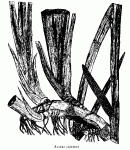OTHER COMMON NAMES—Sweet cane, sweet grass, sweet myrtle, sweet rush, sweet sedge, sweet segg, sweetroot, cinnamon-sedge, myrtle-flag, myrtle-grass, myrtle-sedge, beewort.
HABITAT AND RANGE—This plant frequents wet and muddy places and borders on streams from Nova Scotia to Minnesota, southward to Florida and Texas, also. occurring in Europe and Asia. It is usually partly immersed in water, and is generally found in company with the cat-tall and other water-loving species of flag.
DESCRIPTION OF PLANT—The sword like leaves of the Sweet-Flag resemble those of other flags so much that before the plant is in flower it is difficult to recognize simply by the appearance of its leaves. The leaves of the blue flag or "poison-flag," as it has been called, are very similar to those of the Sweet-Flag, and this resemblance often leads to cases of poisoning among children who thus mistake one for the other. However, as the leaves of the Sweet-Flag are fragrant, the odor will be a means of recognizing it. Of course when the Sweet-Flag is in flower the identification of the plant is easy.
The sheathing leaves of this native perennial, which belongs to the arum family (Araceae), are from 2 to 6 feet in height and about 1 inch in width; they are sharp pointed and have a ridged midrib running their entire length. The flowering head, produced from the side of the stalk, consists of a fleshy spike sometimes 3 ½ inches long and about one-half inch in thickness, closely covered with very small, greenish yellow flowers, which appear from May to July.
DESCRIPTION OF ROOTSTOCK—The long, creeping rootstock of the Sweet-Flag is thick and fleshy, somewhat spongy, and producing numerous rootlets. The odor is aromatic and agreeable, and taste pungent and bitter. The dried article, as found in the stores, consists of entire or split pieces of various lengths from 3 to 6 inches, light brown on the outside with blackish spots, sharply wrinkled lengthwise, the upper surface marked obliquely with dark leaf scars, and the lower surface showing many small circular scars, which, at first glance, give one the impression that the root is worm-eaten, but which are the remains of rootlets that have been removed from the rootstock. Internally the rootstock is whitish and of a spongy texture. The aromatic odor and pungent, bitter taste are retained in the dried article.
COLLECTION, PRICES AND USES—The United States Pharmacopoeia directs that the unpeeled rhizome, or rootstock, be used. It is collected either in early spring or late in autumn. It is pulled or grubbed from the soft earth, freed from adhering dirt, and the rootlets removed, as these are not so aromatic and more bitter. The rootstock is then carefully dried, sometimes by means of moderate heat. Sweet-Flag deteriorates with age and is subject to the attacks of worms. It loses about three-fourths of its weight in drying.
Some of the Sweet-Flag found in commerce consists of handsome white pieces. These usually come from Germany, and have been peeled before drying, but they are not so strong and aromatic as the unpeeled roots. Unpeeled Sweet-Flag brings from 3 to 6 cents a pound.
Sweet-Flag is employed as an aromatic stimulant and tonic in feeble digestion. The dried root is frequently chewed for the relief of dyspepsia.
Ginseng and Other Medicinal Plants, 1936, was written by A. R. Harding.


